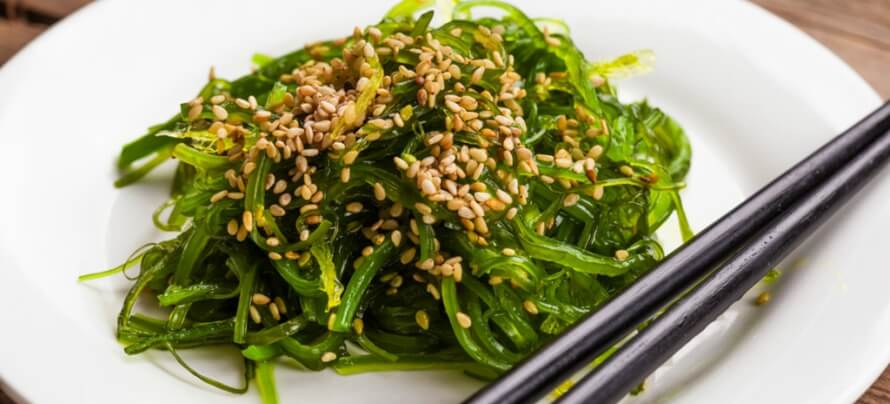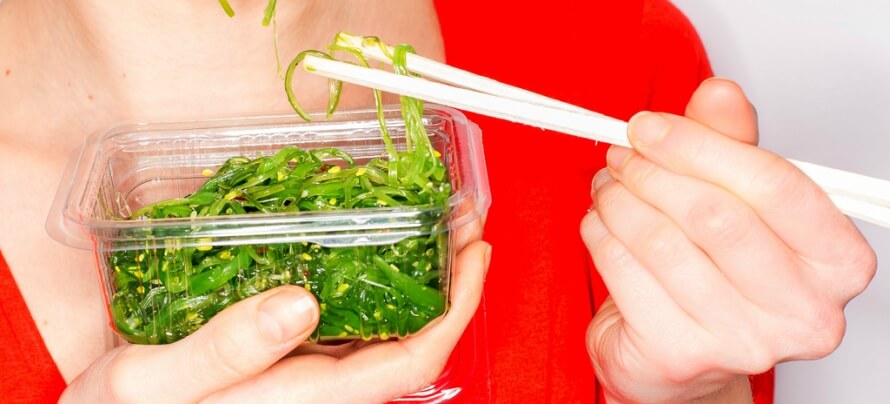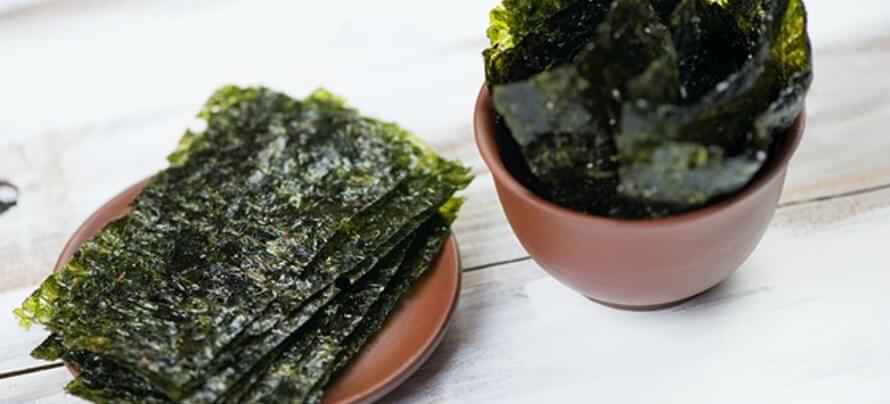Key Takeaways
- Seaweed had a short stint as a “superfood” recently but the hype quickly died out.
- While not the healthiest plant out there, seaweed is rich in unique nutrients and a relatively unique source of iodine. Adding it to your diet may be better than omitting it.
- Dedicated seaweed supplements may be a bit overkill at this time but there are more than enough health benefits to include a bit in your diet.
If I had any superpower in this world, it would be the ability to look into the past.
You might think I would utilize this for beneficial purposes, like understanding historical context to a better degree or perhaps salvaging the Library of Alexandria but nay—I have much more childlike questions to answer first.
Most of them are centralized around “Why in the hell would you want to put that in your mouth?”
When I think of seaweed I don’t normally think of yum yum happy time. I think of how if you misstep in the water then there’s a chance the swamp tentacles are going to lovingly slime your lower bodies … just thinking about stepping in seaweed is making me shudder.
What genius thought that would be delicious and healthy?
Cause I want to thank him.
Turns out seaweed is actually pretty damn good for you. Beyond the health aspects though, I love it from a research perspective. The stuff that’s in food is subject to how the plant evolved after all and seaweed is drastically different than land-based plants.
We have yet to uncover all the secrets of the sea even when we’re referring to pictures of animals, so how many new secrets lay in the hidden recesses of seaweeds, coral, and other molecules that’ve never before seen the atmosphere?
So today I’m going to break down the benefits of seaweed and a few of the unique bioactives in various sea veggies.
Let’s get started.
- What Is Seaweed?
- Why Do People Eat Seaweed?
- What’s in Seaweed?
- What Health Benefits Can I Expect from Seaweed?
- How Much Seaweed Should You Eat?
- What’s the Best Kind of Seaweed?
- How to Get More Seaweed in Your Diet
- The Bottom Line on Seaweed
Table of Contents
+What Is Seaweed?
Seaweed is the common way to refer to various forms of algae in the ocean. While there are well beyond thousands of different types of algae that fall under the umbrella term “seaweed” us landlubbers tend to just use the common word to refer to them all.
In practice, seaweed (technically algae) is usually broken down into three categories:
- Red seaweed. Algae from the Rhodophyta division which include dulse and nori (the seaweed that wraps sushi.)
- Brown seaweed. Algae from the Phaeophyceae class which include Kelp, Kombu, and Wakame (brown seaweeds are likely the most common in the diet.)
- Green seaweed. Algae not traced back to any single class but including Sea Grapes and Chlorella.
Spirulina is a blue-green algae so it doesn’t neatly fall into any of the above categories. That’s fine, though, as the blue-green group is normally quite toxic and spirulina is the outlier.
Now, why did I break it down into three categories?
As a general rule of thumb, when it comes to plants and what are found in plants, the closer the plants are genetically related the more likely it is that they share the same bioactives. If there’s a goodie in brown seaweed that you like then it’s possible that it’s in other brown seaweed sources, and more likely to be in them than green seaweed.
We see this a lot with the cruciferous vegetables. Beneficial compounds like sulforaphane and PEITC are usually attributed to broccoli but are present in kale, brussels sprouts, and even moringa oleifera.
This is why I wanted to write this article in the first place since seaweeds, while related to each other, are things that are not in many people’s diets. If people over here in the West do eat seaweed it’s usually just nori wrapping for sushi which is an abysmal dose.
Seaweeds have various unique, cool, and potentially highly beneficial compounds in them that are not found in land plants. Compounds that may lead you to reconsider if you have seaweed in your diet or not.
Why Do People Eat Seaweed?

At some point in my life I asked myself the same question. Never really thought seaweed could have taste until I heard that dulse (palmaria palmata) has a slight bacon taste to it.
However, lets ignore taste issues for now and just focus on the health claims that people tend to make when advocating for others to increase the seaweed in their diets.
Most claims circulate around the antioxidant potential and, at times, a high fiber listing on food labels which led to claims that it’s quite gut healthy. It definitely can help speed things along in the intestines if you eat too much of it but that’s not all too pleasant an experience.
Then, perhaps the most valid claim, is that seaweed can be a great source of iodine. This is true, and a great thing to remember for any vegetarian or vegan that does not frequently use table salt or eat prepackaged foods since the only other major iodine source beyond salt and junk food would be meat (both inherently and how salt is a common preservative).
Beyond that then it just gets into nutritional fetishistic territory.
Seriously, look around and you’ll see article after article trying to link seaweed to all the unique benefits of Japanese people. Mentioning the long life span of Okinawans is quite popular, so is mentioning that dietary supplements in Japan tend to focus on the gut a lot more than we do here in the West (so obviously seaweed is good for the gut, right, right?)
So, seaweed is eaten all over the world. Super popular in Iceland in the form of dulse.
What’s in Seaweed?
While each specific species of seaweed is going to differ the major groups of molecules, or specific molecules, let’s go over the ones that are unique to seaweed or are found in relatively greater doses.
Seaweed and Fucoxanthin
In Triumph we have lutein and zeaxanthin as two nutritive carotenoids. These molecules are pretty common in many multivitamins and are well researched for benefits pertaining to eye health (with more recent evidence suggesting cognitive benefits during aging as well.)
Fucoxanthin, however, slips into the formulation as well. This is very much an atypical carotenoid. So, why did we include it and what is it?
Fucoxanthin is the pigment that gives brown seaweed it’s color. It seems to be specific for seaweed as brown stuff on land gets their brown color from other pigments and has evidence to suggest it could be a non-stimulatory fat burner.
Fucoxanthin can be absorbed after ingestion (although it is best paired with sources of dietary fat) and even if eaten through seaweed itself rather than an isolated pill.
It initially rose to fame after this study was published, which found is increased metabolic rate by 1,915 kJ/day (458 calories) and caused around 5 kilograms (11 pounds) of weight loss after 16 weeks.
Yeah, that study is incredibly sketchy. Hasn’t been replicated either … wonder why.
Regardless, other studies do note that fucoxanthin can increase the expression of an adrenaline receptor on fat cells (β3 in particular) and increasing the process of uncoupling in white fat—the “waste” of energy as heat rather than any productive purpose (you can read a little more about this here).
If you’ve ever heard of how brown fat is “better” for you than white fat it’s because of elevated levels of uncoupling leading to more calories being burned and, thus, less risk for obesity. Increasing uncoupling in white fat is a pretty great idea for long-term fat loss since humans don’t have much brown fat to work with (on average.)
(Funny side note. It was once thought that fucoxanthin could convert white fat into brown fat but researchers sort of forgot that fucoxanthin was just a brown pigment making it look different.)
The above, as well as general health properties that are nowhere near as interesting as the following section, are why we slipped fucoxanthin into Triumph. Evidence isn’t strong enough to support it being in a standalone supplement but, hey, we got it for pretty cheap and you might lose an extra pound or two of fat after a few months.
Seaweed and Fucoidans
Fucoidan refers to a particular polysaccharide type that can be found in brown seaweed. There are many fucoidan variants but they are all similar in how they are sulfated polysaccharides.
A polysaccharide is a group of sugars bound together into a larger structure (a carbohydrate essentially) while sulfated polysaccharide is one with sulphur molecules attached to it.
The seaweeds kombu, wakame, and mozuku are all about 1% fucoidans wet weight.
If you don’t know what this means know that we only really get sulfur in our diet via dietary protein (the amino acids methionine and cysteine, potentially some from taurine) and provision of sulfur underlies a large amount of the benefits of garlic supplementation.
The benefits I speak of tend to involve improvements in blood flow and circulation (due to creating hydrogen sulfide in the body) and improvements in antioxidant defense by supporting glutathione and other defense systems.
To have a polysaccharide, a group of molecules that are usually associated with immune system benefits (like in reishi or astragalus) peppered with sulfur molecules is interesting to say the least.
Not only that, they can be absorbed from the intestines and detected in the urine after consumption of seaweed and, in rats, can bioaccumulate in the kidneys and liver with extended circulation times.
This means that, rather than treating this like a healthy fiber source, we can treat fucoidans more like a potent antioxidant that can benefit (most of) our bodily organs.
There are many in vitro studies showing the properties of fucoidans but, when it comes to human studies, we find that fucoidan supplementation:
- Can improve disease control rate (looking at lesions in the intestines and whether they healed/shrunk or not) of patients with colorectal cancer.
- Can alter the function of immune cells (increase a certain receptors expression) which may be how it helps improve immune responses to vaccination.
- May reduce blood pressure in overweight adults (although this study did not an increase in insulin resistance… weird).
Personally speaking I like the data on the kidneys the best, since having supplements actually help the kidneys is rather rate. Rodent and in vitro evidence suggest anti-inflammatory and antioxidant roles in the kidneys paired with general protective effects against stressors.
If the bioaccumulation in rats also applies to humans then fucoidans are set to be a potential kidney health supplement that you may be able to simply eat rather than buy a standalone pill or powder for it.
While human evidence is preliminary, there is at least one study suggesting improved immunity and another showing better handling of colon cancer. Fucoidans may have a future as a kidney health supplement.
Seaweed and Iodine
Iodine, the essential dietary mineral that supports optimal thyroid health, has long been associated with the sea. Initially in the form of salt, nowadays most people get sufficient iodine from iodized salt (which also makes its way into meat products and many processed foods.)
Ironically, iodine is one of the two dietary minerals (the other being sodium) where deficiency rates may be higher in those who strive for healthy diets rather than those who eat junk food— that being said sodium deficiency is rare enough that it sounds silly.
Iodine, however, can be something you can be deficient in if you are a vegetarian or vegan that omits iodized salt from your food and doesn’t eat any processed food. Unless you eat sea vegetables then added salt is really the only good way of getting iodine.
Hence, sea vegetables have been associated with being the “healthiest” option for getting iodine. To some people seaweed is seen as tasty salt with antioxidants.
Just be aware, however, that iodine is also the reason you can’t just go out and eat a pound of seaweed a day. What iodine giveth to the thyroid iodine taketh away in excess after all.
Seaweed, all species, are great sources of iodine since most other vegetables don’t have much if left unsalted. For people who omit table salt and processed food, and who may have inadequate iodine intakes due to this, seaweed becomes outright nutritive.
What Health Benefits Can I Expect from Seaweed?

The only major benefit that you can get from including seaweed in your diet is the iodine issue.
Somebody who is deficient in iodine, and thus has suboptimal thyroid function, may experience fatigue and lethargy paired with less than optimal cognition and fat loss—all around a bad experience. Restoring the iodine deficiency can do absolute wonders in this case.
For people who don’t want to increase the sodium in their diets, perhaps due to being placed on a sodium-limited blood pressure reducing diet, seaweed is the only good option beyond supplementation itself.
Beyond that, including a small amount of seaweed may result in beneficial changes to digestion but this can also be reversed if you take too much seaweed. When it comes to digestion it’s a balancing game that you will need to play around with but ordering a side of seaweed next time you visit a sushi place could be a good starting point to test this out.
All other benefits of seaweed, and the theoretical benefits of fucoxanthin to fat loss and fucoidans to kidney health, are not things that you will notice in the short term. It’s a good example of something you need to put your faith into for optimal benefits which is why it’s good that it’s a food rather than an expensive supplement.
How Much Seaweed Should You Eat?
At this moment in time there is no “ideal” dose of seaweed that gives the optimal health benefits. All we know is that you shouldn’t eat so much that your iodine levels go off the chart.
So that’s a good starting point, eat as much as you want as long as you don’t exceed the tolerable upper level (TUL) of iodine.
The TUL, according to US standards, is currently set at 1,100 mcg for adults or 730% of the RDA value of 150 mcg. The exact level of iodine in seaweed, unfortunately, varies far too widely for me to give estimates here (seriously, even governmental sources state a range of 16 to 2,984 mcg per gram; far too broad to get any useful data from.)
Pay attention to food labels, if possible, and if you plan on eating a lot of seaweed stick to low iodine seaweeds if they’re available.
What’s the Best Kind of Seaweed?
It may be difficult to outright answer that question at this time since seaweeds are a large group of plants and, as we have seen with Spirulina, any individual plant can just spring out of nowhere and surpass others.
But, as a general rule of thumb, brown seaweed seems to have the bioactives that are more researched for their health benefits. If you want to introduce a seaweed into your diet based on what I wrote in this article look for kelps such as kombu or wakame.
If you’re looking for a seaweed supplement then I’m willing to bet it’s gonna be more expensive than you would like but bladderwrack (a type of kelp) has been sold on the market before. It may not be too difficult to get a wakame supplement under the name undaria pinnatifida.
And, of course, if we can pretend that spirulina is a seaweed because it’s also an algae, then I’d throw my vote in for that one.
For dietary purposes just opt for a brown seaweed. For supplemental purposes either pretend that spirulina is a seaweed and opt for that or seek out undaria pinnatifida (wakame) supplements.
How to Get More Seaweed in Your Diet

To get more seaweed in your diet, expand your shopping list and perhaps where you shop.
Seaweed is a very common food ingredient in coastal nations and this is not just limited to Japan. The Koreas, island nations south of China, and even Scandinavian countries use brown seaweed in their cuisine.
You might even be able to find seaweed snack chips if you can find an Icelandic specialty store; those are the ones that taste like bacon (or are supposed to, at least; never tried them.) Just be aware that these “sea lettuce flakes” or “dulse” are red seaweed (still good but limited fucoxanthin.)
The Bottom Line on Seaweed
It’s not incorrect to call seaweed one of the more “revolutionary” vegetables for Western diets.
They’re simply grown in new environments, at different times of the year, and provide a wealth of new bioactives with unforeseen benefits. A drastically different vegetable in a world where most fruits and veggies are interchangeable (nutritionally) and those that differ, such as broccoli, are elevated to superfood levels.
Seaweed may or may not be a superfood, but at the very least it’s interesting. It’s like a vigilante–food or something, an antihero–food; the Deadpool of the kitchen rife with unsavory tentacle references. Just don’t put seaweed in your chimichanga—that’s sacrilegious.










